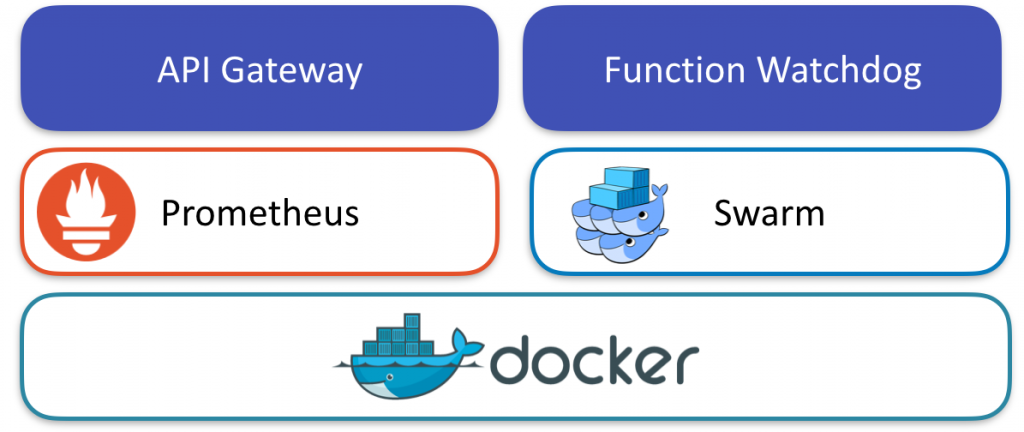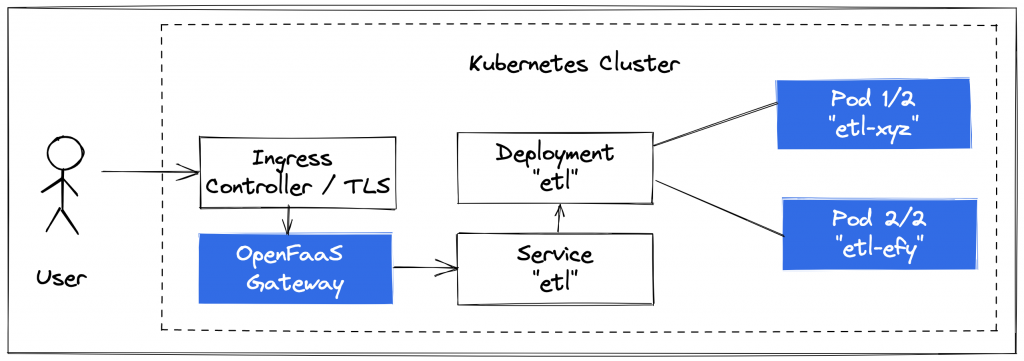
1) What is OpenFaaS used for?
What is OpenFaas? OpenFaas ( Function as a Service) is a framework for building serverless functions on the top of containers (with docker and kubernetes).
With the help of OpenFaas, it is easy to turn anything into a serverless function that runs on Linux or windows through Docker or Kubernetes.
2) What are the components of OpenFaaS?

OpenFaaS architecture is based on a cloud-native standard and includes the following components: API Gateway, Function Watchdog, and the container orchestrators Kubernetes,
Docker Swarm, Prometheus, and Docker.
3) What is the default timeout for OpenFaaS?
The best way to set the timeout is in the YAML file generated by the faas-cli . The default for both is “8” – seconds.
4) Which companies use OpenFaaS?
Who uses OpenFaaS? 5 companies reportedly use OpenFaaS in their tech stacks, including waylay, DevOPS and Infrastructure, and jjjj.
5) What languages does OpenFaaS support?
You can build OpenFaaS functions from a set of supported language templates (such as Node. js, Python, CSharp and Ruby).
That means you just write a handler file such as (handler.py/handler.js) and the CLI does the rest to create a Docker image.
6) What is the default user for OpenFaaS?
The default user is admin and your password can be retrieved by using echo $PASSWORD . Finally, install the OpenFaaS CLI.
This example used brew, see the OpenFaaS CLI documentation for more options.
8) How to remove function in OpenFaaS?

You can remove functions by using the CLI. If you specify a YAML file the CLI will remove all the deployed functions listed in the file. $ faas-cli rm -f callme.
9) How do I deploy a function in OpenFaaS?
The OpenFaaS Operator
The easiest way to deploy functions right now is by using the faas-cli commands. The CLI uses the OpenFaaS REST API to deploy functions.
In modern production environments you might want to use a GitOps approach to deploy build artefacts from your Continuous Integration pipeline to your cluster.
10) How to install OpenFaaS on Windows?
To install OpenFaas we need to clone the git repo for faas-netes, which is the Kubernetes implementation of OpenFaaS. Navigate to a directory of your choice
on the Windows command line and then clone the repo. Change the directory to where faas-netes was downloaded.
11) What is an example of FaaS in our daily lives?
Some popular examples of FaaS include:
Amazon’s AWS Lambda. Google Cloud Functions. Microsoft Azure Functions (open source) OpenFaaS (open source)
12) Does FaaS use containers?
The reason containers are optional for FaaS solutions is because it is the responsibility of the cloud service provider to determine how to run your functions.
Some cloud service providers use containers to deploy their FaaS offerings while others do not.
13) Which of the following are attributes of FaaS?
FaaS has the following characteristics:
Infrastructure is hidden from the customer and fully managed by the Cloud Service Provider.
Resources are allocated as needed.
Customers pay only for consumption and execution.
Functions are triggered by events.
14) Is OpenFaaS open source?
OpenFaaS ® is an independent open-source project created by Alex Ellis, which is being built and shaped by a growing community of contributors.
15) What are the components of OpenFaaS?
OpenFaaS architecture is based on a cloud-native standard and includes the following components: API Gateway, Function Watchdog, and the
container orchestrators Kubernetes, Docker Swarm, Prometheus, and Docker.
16) What are the uses of OpenFaaS?
OpenFaaS® makes it easy for developers to deploy event-driven functions and microservices to Kubernetes without repetitive, boiler-plate coding.
Package your code or an existing binary in a Docker image to get a highly scalable endpoint with auto-scaling and metrics.
17) What is the difference between OpenFaaS community and pro?
OpenFaaS Community Edition (CE) is meant for open-source developers and initial exploration of functions, OpenFaaS Pro is meant for production.
OpenFaaS Pro is a distribution of OpenFaaS with additional features and configurations that we believe customers need to operate a product or service in production.
18) Why is FaaS better than PaaS?
FaaS and PaaS have different strengths and weaknesses. The main difference between them is that with FaaS you must use a framework that
handles all aspects of deployment such as scalability and security management while with PaaS there’s no need for these issues because they’re handled by external cloud providers.
19) What is the default login for OpenFaaS?
The default username is admin and the password is the one you specified in the deployment instructions above, you can print this to your console using echo $PASSWORD .
You can try various functions from the OpenFaaS ‘store’ from within the UI. For example: Click the “Deploy New Function” button.
20) Does FaaS support VM and networking?
With FaaS, the physical hardware, virtual machine operating system, and web server software management are all handled automatically by your cloud service provider.
This allows you to focus solely on individual functions in your application code.
21) What is the main benefit of FaaS?
FaaS lets developers write and update a piece of code on the fly, which can then be executed in response to an event, such as a user clicking on an element in a web application.
This makes it easy to scale code and is a cost-efficient way to implement microservices.
22) Does FaaS provide server hardware?
Even though FaaS users do not manage or even see the hardware, the FaaS model does run on servers. The hardware is owned, operated, and managed by the CSP,
so customers can take full advantage of the functionality on demand, without purchasing or maintaining their own servers.
23) How are functions in FaaS triggered?
OpenFaaS functions can be triggered easily by any kind of event. The most common use-case is HTTP which acts as a lingua franca between internet-connected systems.
Connectors map one or more topics, subjects or queues from a stateful messaging system or event-source to a number of functions in your cluster.
24) What category is FaaS?
Function as a service (FaaS) is a category of cloud computing services that provides a platform allowing customers to develop, run, and manage application
functionalities without the complexity of building and maintaining the infrastructure typically associated with developing and launching an app.
25) What is the most popular FaaS?
Azure’s FaaS product, Azure Functions, is its most popular serverless offering, and it is used by more than 40 percent of Azure customers.
26) How to create FaaS?
The approach is similar for different package managers.
Download and enable the OpenFaaS Pro plugin.
Create a local file in the format required.
Update a build_secret in stack.yml so it gets mounted into the container.
Run faas-cli pro build or faas-cli pro publish , faas-cli pro up is not available at this time.
27) What is the concept of FaaS?
FaaS, or Function-as-a-Service, is a cloud-computing service that allows customers to execute code in response to events, without managing
the complex infrastructure typically associated with building and launching microservices applications.
28) When should you use FaaS?
FaaS is often used to deploy microservices and may also be referred to as serverless computing.
Traditional cloud use requires users to provision cloud infrastructure — including virtual servers, storage and services — that hosts application code.
29) What is the role of the context value in OpenFaas?
The context value can be used to store and retrieve data across function invocations.
30) How do you handle retries in OpenFaas?
Retries can be handled using try-catch blocks or by implementing a retry mechanism.
31) What is the role of the context tracing in OpenFaas?
The context tracing is used to trace the execution of a function across multiple services.
32) How do you handle long-running functions in OpenFaas?
Long-running functions can be handled using background tasks or by breaking the function into smaller tasks.
33) What is the role of the context logging in OpenFaas?
The context logging is used to log information about the execution of a function.
34) How do you handle input validation in OpenFaas?
Input validation can be handled using try-catch blocks or by implementing a validation mechanism.
35) What is the role of the context cancellation in OpenFaas?
The context cancellation is used to stop the execution of a function.
36) How do you handle output validation in OpenFaas?
Output validation can be handled using try-catch blocks or by implementing a validation mechanism.
37) What is the role of the context tracing in OpenFaas?
The context tracing is used to trace the execution of a function across multiple services.
38) How do you handle long-running functions in OpenFaas?
Long-running functions can be handled using background tasks or by breaking the function into smaller tasks.
39) What is the role of the context logging in OpenFaas?
The context logging is used to log information about the execution of a function.
40) How do you handle input validation in OpenFaas?
Input validation can be handled using try-catch blocks or by implementing a validation mechanism.
41) What is the role of the context cancellation in OpenFaas?
The context cancellation is used to stop the execution of a function.
42) How do you handle output validation in OpenFaas?
Output validation can be handled using try-catch blocks or by implementing a validation mechanism.
43) What is the role of the context tracing in OpenFaas?
The context tracing is used to trace the execution of a function across multiple services.
44) How do you handle long-running functions in OpenFaas?
Long-running functions can be handled using background tasks or by breaking the function into smaller tasks.
45) What is the role of the context logging in OpenFaas?
The context logging is used to log information about the execution of a function.
46) How do you handle input validation in OpenFaas?
Input validation can be handled using try-catch blocks or by implementing a validation mechanism.
47) What is the role of the context cancellation in OpenFaas?
The context cancellation is used to stop the execution of a function.
48) How do you handle output validation in OpenFaas?

Output validation can be handled using try-catch blocks or by implementing a validation mechanism.
49) What is the role of the context tracing in OpenFaas?
The context tracing is used to trace the execution of a function across multiple services.
50) How do you handle long-running functions in OpenFaas?
Long-running functions can be handled using background tasks or by breaking the function into smaller tasks.
Related video:
- Degree Pursuit: Navigating the Path to Educational Excellence - July 4, 2024
- Why Is Studying English Important in a Business Environment? - July 4, 2024
- Top 10 Data Science Skills You Need in 2024 - July 3, 2024

